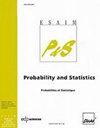薄立方晶格中的狄利克雷拉普拉斯谱
IF 0.7
4区 数学
Q4 STATISTICS & PROBABILITY
引用次数: 0
摘要
我们给出了一个由方形横截面的细条(宽度为$\eps\ll1$)组成的无界三维周期晶格中狄利克雷拉普拉斯谱的下半部分的描述。这个频谱与所有到$+\infty$的片段的并集一致,因为$\eps$由于Dirichlet边界条件趋于零。我们发现,第一个光谱段非常紧密,长度为$O(e^{-\delta/\eps})$, $\delta>0$,而下一个光谱段的长度为$O(\eps)$。为了建立这些结果,我们需要详细研究狄利克雷拉普拉斯算子$A^{\Om}$在几何图形$\Om$中的性质,这些几何图形是通过缩放初始周期晶格的结区得到的。这个问题有它自己的兴趣,并与最大最小参数以及精心选择的Friedrichs不等式一起使用对称性,我们证明了$A^{\Om}$在其离散谱中具有唯一的特征值,该特征值生成了第一个谱段。此外,我们证明了$A^{\Om}$没有阈值共振,即在$A^{\Om}$的阈值频率处没有非平凡的有界解。这意味着下一个谱段的晶格的正确一维模型是一个在顶点处具有狄利克雷条件的极限图上的常微分方程系统。我们还提供了数字来补充分析。本文章由计算机程序翻译,如有差异,请以英文原文为准。
Spectrum of the Dirichlet Laplacian in a thin cubic lattice
We give a description of the lower part of the spectrum of the Dirichlet Laplacian in an unbounded 3D periodic lattice made of thin bars (of width $\eps\ll1$) which have a square cross section. This spectrum coincides with the union of segments which all go to $+\infty$ as $\eps$ tends to zero due to the Dirichlet boundary condition. We show that the first spectral segment is extremely tight, of length $O(e^{-\delta/\eps})$, $\delta>0$, while the length of the next spectral segments is $O(\eps)$. To establish these results, we need to study in detail the properties of the Dirichlet Laplacian $A^{\Om}$ in the geometry $\Om$ obtained by zooming at the junction regions of the initial periodic lattice. This problem has its own interest and playing with symmetries together with max-min arguments as well as a well-chosen Friedrichs inequality, we prove that $A^{\Om}$ has a unique eigenvalue in its discrete spectrum, which generates the first spectral segment. Additionally we show that there is no threshold resonance for $A^{\Om}$, that is no non trivial bounded solution at the threshold frequency for $A^{\Om}$. This implies that the correct 1D model of the lattice for the next spectral segments is a system of ordinary differential equations set on the limit graph with Dirichlet conditions at the vertices. We also present numerics to complement the analysis.
求助全文
通过发布文献求助,成功后即可免费获取论文全文。
去求助
来源期刊

Esaim-Probability and Statistics
STATISTICS & PROBABILITY-
CiteScore
1.00
自引率
0.00%
发文量
14
审稿时长
>12 weeks
期刊介绍:
The journal publishes original research and survey papers in the area of Probability and Statistics. It covers theoretical and practical aspects, in any field of these domains.
Of particular interest are methodological developments with application in other scientific areas, for example Biology and Genetics, Information Theory, Finance, Bioinformatics, Random structures and Random graphs, Econometrics, Physics.
Long papers are very welcome.
Indeed, we intend to develop the journal in the direction of applications and to open it to various fields where random mathematical modelling is important. In particular we will call (survey) papers in these areas, in order to make the random community aware of important problems of both theoretical and practical interest. We all know that many recent fascinating developments in Probability and Statistics are coming from "the outside" and we think that ESAIM: P&S should be a good entry point for such exchanges. Of course this does not mean that the journal will be only devoted to practical aspects.
 求助内容:
求助内容: 应助结果提醒方式:
应助结果提醒方式:


